2017 NISSAN VERSA SEDAN coolant
[x] Cancel search: coolantPage 361 of 404
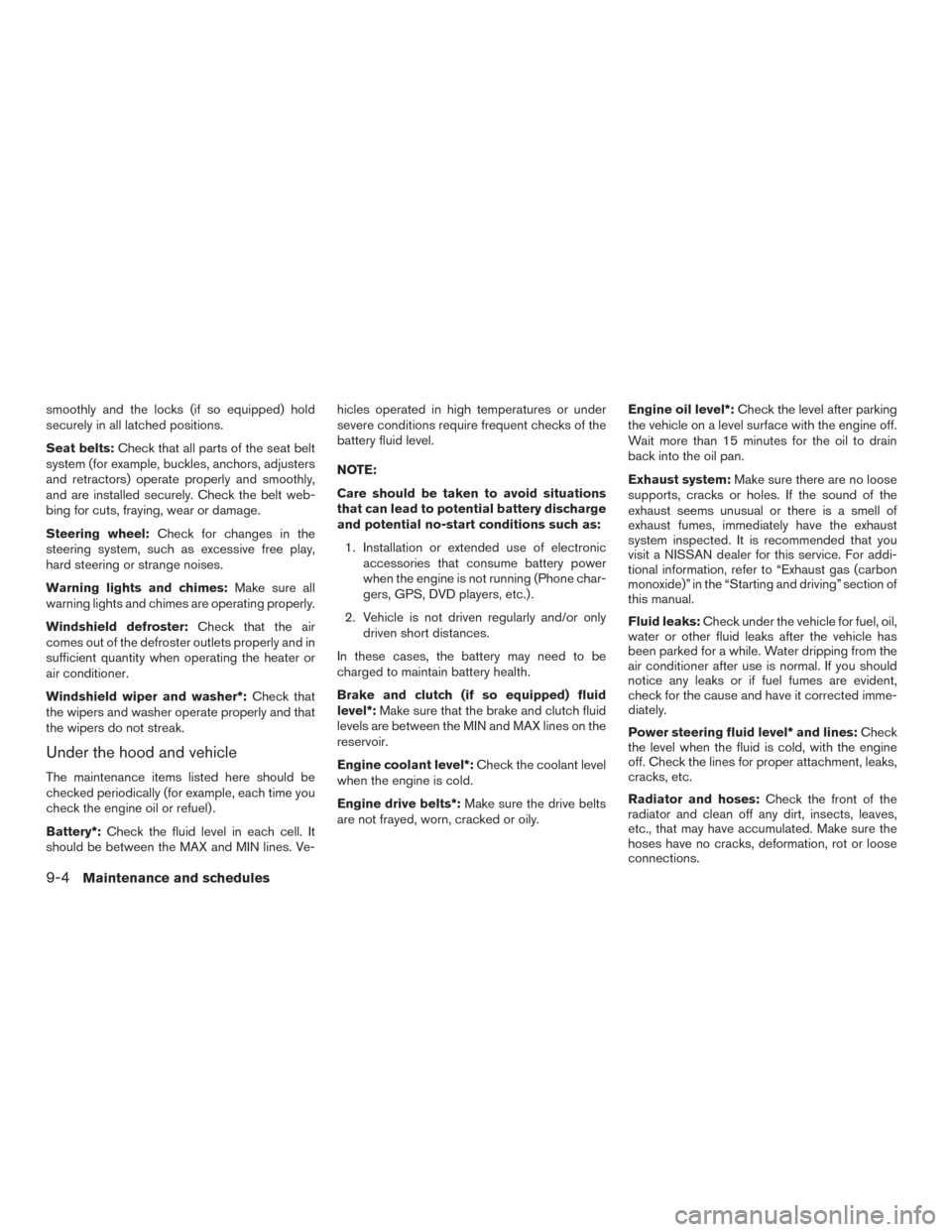
smoothly and the locks (if so equipped) hold
securely in all latched positions.
Seat belts:Check that all parts of the seat belt
system (for example, buckles, anchors, adjusters
and retractors) operate properly and smoothly,
and are installed securely. Check the belt web-
bing for cuts, fraying, wear or damage.
Steering wheel: Check for changes in the
steering system, such as excessive free play,
hard steering or strange noises.
Warning lights and chimes: Make sure all
warning lights and chimes are operating properly.
Windshield defroster: Check that the air
comes out of the defroster outlets properly and in
sufficient quantity when operating the heater or
air conditioner.
Windshield wiper and washer*: Check that
the wipers and washer operate properly and that
the wipers do not streak.
Under the hood and vehicle
The maintenance items listed here should be
checked periodically (for example, each time you
check the engine oil or refuel) .
Battery*: Check the fluid level in each cell. It
should be between the MAX and MIN lines. Ve- hicles operated in high temperatures or under
severe conditions require frequent checks of the
battery fluid level.
NOTE:
Care should be taken to avoid situations
that can lead to potential battery discharge
and potential no-start conditions such as:
1. Installation or extended use of electronic accessories that consume battery power
when the engine is not running (Phone char-
gers, GPS, DVD players, etc.) .
2. Vehicle is not driven regularly and/or only driven short distances.
In these cases, the battery may need to be
charged to maintain battery health.
Brake and clutch (if so equipped) fluid
level*: Make sure that the brake and clutch fluid
levels are between the MIN and MAX lines on the
reservoir.
Engine coolant level*: Check the coolant level
when the engine is cold.
Engine drive belts*: Make sure the drive belts
are not frayed, worn, cracked or oily. Engine oil level*:
Check the level after parking
the vehicle on a level surface with the engine off.
Wait more than 15 minutes for the oil to drain
back into the oil pan.
Exhaust system: Make sure there are no loose
supports, cracks or holes. If the sound of the
exhaust seems unusual or there is a smell of
exhaust fumes, immediately have the exhaust
system inspected. It is recommended that you
visit a NISSAN dealer for this service. For addi-
tional information, refer to “Exhaust gas (carbon
monoxide)” in the “Starting and driving” section of
this manual.
Fluid leaks: Check under the vehicle for fuel, oil,
water or other fluid leaks after the vehicle has
been parked for a while. Water dripping from the
air conditioner after use is normal. If you should
notice any leaks or if fuel fumes are evident,
check for the cause and have it corrected imme-
diately.
Power steering fluid level* and lines: Check
the level when the fluid is cold, with the engine
off. Check the lines for proper attachment, leaks,
cracks, etc.
Radiator and hoses: Check the front of the
radiator and clean off any dirt, insects, leaves,
etc., that may have accumulated. Make sure the
hoses have no cracks, deformation, rot or loose
connections.
9-4Maintenance and schedules
Page 363 of 404

Engine coolant*:Replace coolant at the speci-
fied interval. When adding or replacing coolant,
be sure to use only Genuine NISSAN Long Life
Antifreeze/Coolant (blue) or equivalent with the
proper mixture. (For additional information on the
proper mixture for your area, refer to “Engine
cooling system” in the “Do-it-yourself” section of
this manual.)
NOTE: Mixing any other type of coolant or
the use of non-distilled water may reduce
the recommended service interval of the
coolant.
Engine oil and oil filter: Replace engine oil
and oil filter at the specified intervals. For recom-
mended oil grade and viscosity refer to “Recom-
mended fluids/lubricants and capacities” in the
“Technical and consumer information” section of
this manual.
Fuel lines*: Check the fuel hoses, piping and
connections for leaks, looseness, or deteriora-
tion. Tighten connections or replace parts as
necessary.
Spark plugs: Replace at specified intervals. In-
stall new plugs of the type as originally equipped.CHASSIS AND BODY
MAINTENANCE:
Brake lines and cables: Visually inspect for
proper installation. Check for chafing, cracks,
deterioration, and signs of leaking. Replace any
deteriorated or damaged parts immediately.
Brake pads, rotors, drums and linings:
Check for wear, deterioration and fluid leaks.
Replace any deteriorated or damaged parts im-
mediately.
Exhaust system: Visually inspect the exhaust
pipes, muffler and hangers for leaks, cracks, de-
terioration, and damage. Tighten connections or
replace parts as necessary.
In-cabin microfilter: Replace at specified in-
tervals. When driving for prolonged periods in
dusty conditions, replace the filter more fre-
quently.
Steering gear and linkage, axle and sus-
pension parts, drive shaft boots: Check for
damage, looseness, and leakage of oil or grease.
Under severe driving conditions, inspect more
frequently. Tire rotation:
Tires should be rotated every
5,000 miles (8,000 km) according to the instruc-
tions under “General maintenance” in this sec-
tion. When rotating tires, check for damage and
uneven wear. Replace if necessary.
Transmission fluid/oil: Visually inspect for
signs of leakage at specified intervals.
If towing a trailer, using a camper or car-top
carrier, or driving on rough or muddy roads, re-
place the CVT fluid every 60,000 miles
(96,000 km) or request the dealer to inspect the
fluid deterioration data using a CONSULT. If the
deterioration data is more than 210000, replace
the CVT fluid.
9-6Maintenance and schedules
Page 365 of 404
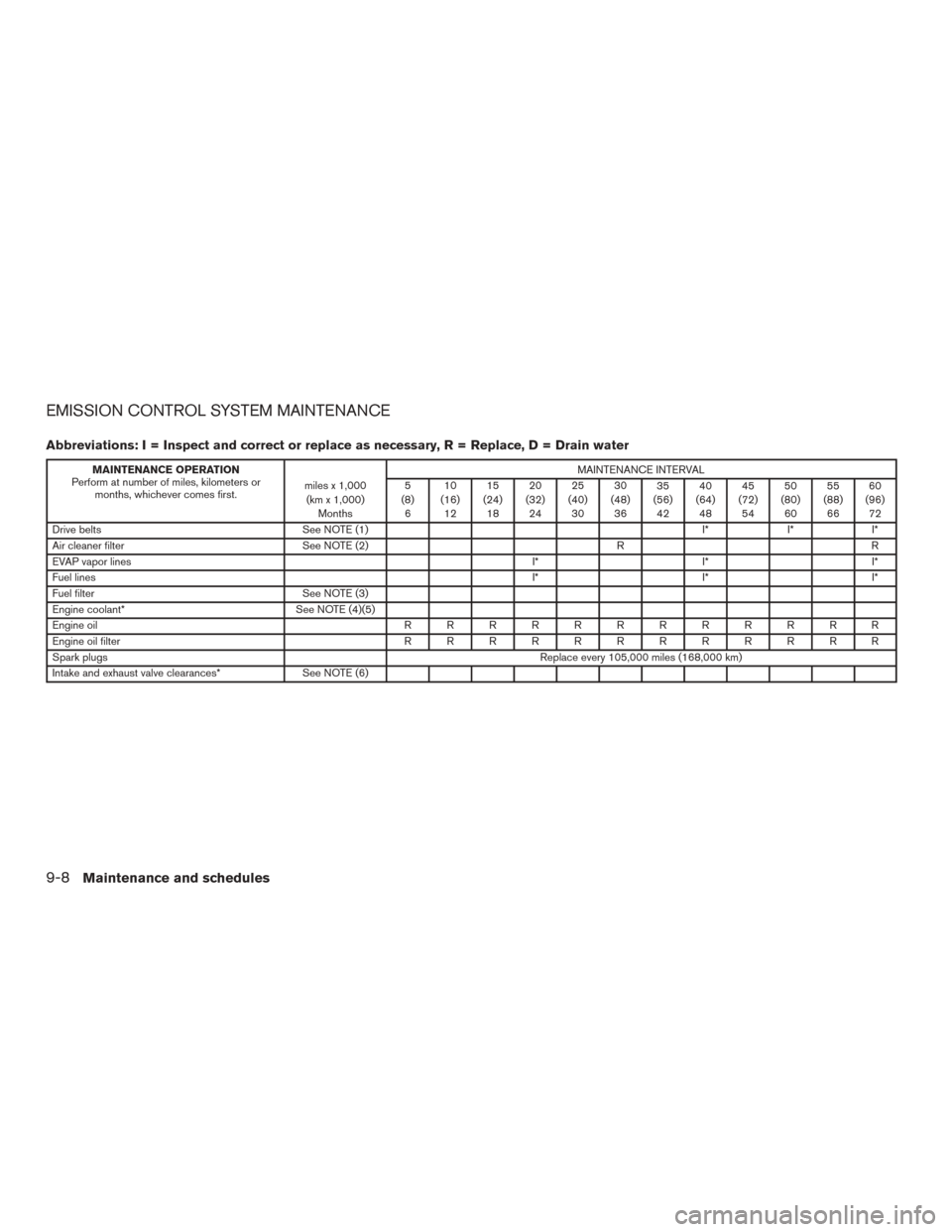
EMISSION CONTROL SYSTEM MAINTENANCE
Abbreviations: I = Inspect and correct or replace as necessary, R = Replace, D = Drain water
MAINTENANCE OPERATION
Perform at number of miles, kilometers or months, whichever comes first. miles x 1,000
(km x 1,000) Months MAINTENANCE INTERVAL
5
(8) 6 10
(16) 12 15
(24) 18 20
(32) 24 25
(40) 30 30
(48) 36 35
(56) 42 40
(64) 48 45
(72) 54 50
(80) 60 55
(88) 66 60
(96) 72
Drive belts See NOTE (1) I*I*I*
Air cleaner filter See NOTE (2) RR
EVAP vapor lines I*I*I*
Fuel lines I*I*I*
Fuel filter See NOTE (3)
Engine coolant* See NOTE (4)(5)
Engine oil RRRRRRRRRRRR
Engine oil filter RRRRRRRRRRRR
Spark plugs Replace every 105,000 miles (168,000 km)
Intake and exhaust valve clearances* See NOTE (6)
9-8Maintenance and schedules
Page 366 of 404
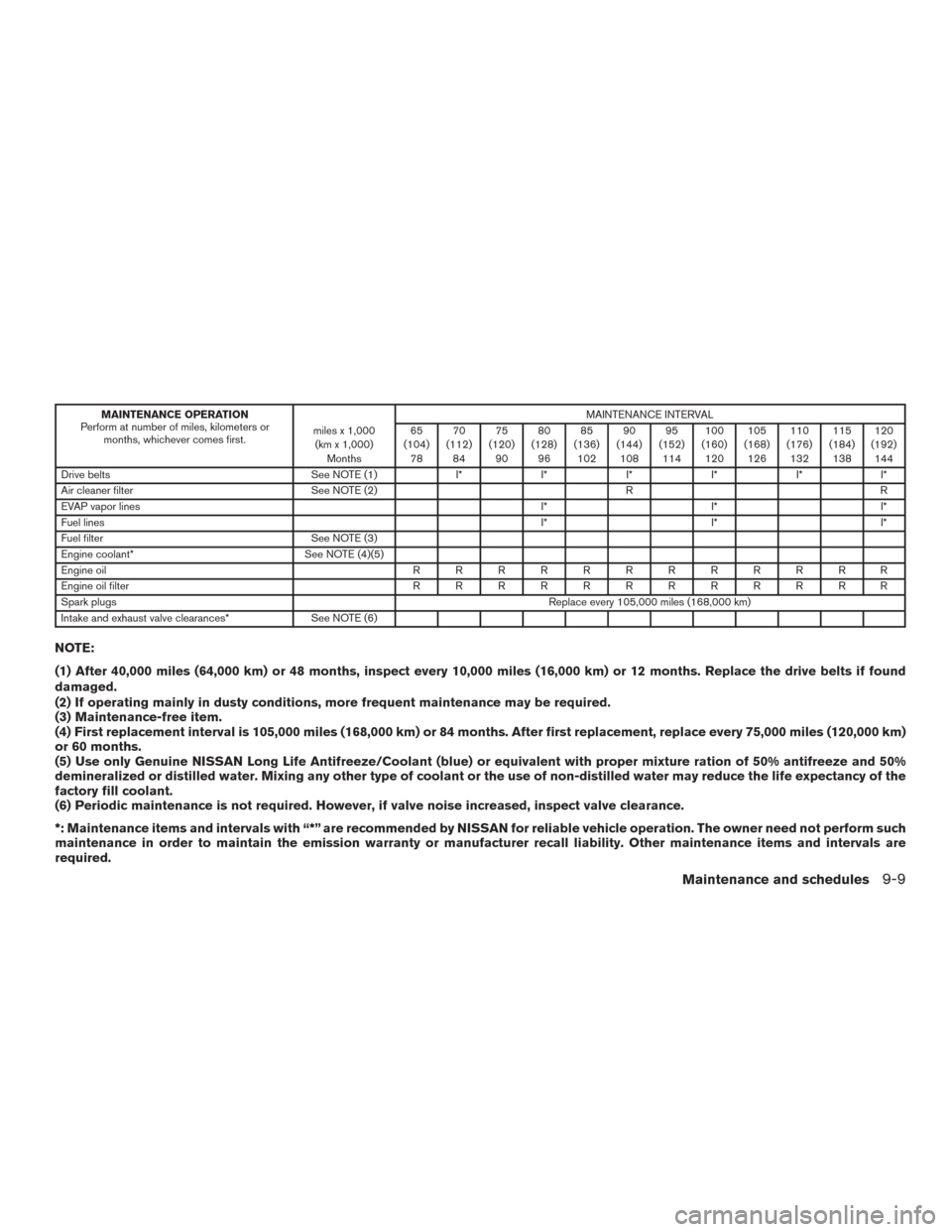
MAINTENANCE OPERATION
Perform at number of miles, kilometers or months, whichever comes first. miles x 1,000
(km x 1,000) Months MAINTENANCE INTERVAL
65
(104) 78 70
(112) 84 75
(120) 90 80
(128) 96 85
(136) 102 90
(144) 108 95
(152) 114 100
(160) 120 105
(168) 126 110
(176) 132 115
(184) 138 120
(192) 144
Drive belts See NOTE (1)I*I*I*I*I*I*
Air cleaner filter See NOTE (2) RR
EVAP vapor lines I*I*I*
Fuel lines I*I*I*
Fuel filter See NOTE (3)
Engine coolant* See NOTE (4)(5)
Engine oil RRRRRRRRRRRR
Engine oil filter RRRRRRRRRRRR
Spark plugs Replace every 105,000 miles (168,000 km)
Intake and exhaust valve clearances* See NOTE (6)
NOTE:
(1) After 40,000 miles (64,000 km) or 48 months, inspect every 10,000 miles (16,000 km) or 12 months. Replace the drive belts if found
damaged.
(2) If operating mainly in dusty conditions, more frequent maintenance may be required.
(3) Maintenance-free item.
(4) First replacement interval is 105,000 miles (168,000 km) or 84 months. After first replacement, replace every 75,000 miles (120,000 km)
or 60 months.
(5) Use only Genuine NISSAN Long Life Antifreeze/Coolant (blue) or equivalent with proper mixture ration of 50% antifreeze and 50%
demineralized or distilled water. Mixing any other type of coolant or the use of non-distilled water may reduce the life expectancy of the
factory fill coolant.
(6) Periodic maintenance is not required. However, if valve noise increased, inspect valve clearance.
*: Maintenance items and intervals with “*” are recommended by NISSAN for reliable vehicle operation. The owner need not perform such
maintenance in order to maintain the emission warranty or manufacturer recall liability. Other maintenance items and intervals are
required.
Maintenance and schedules9-9
Page 375 of 404
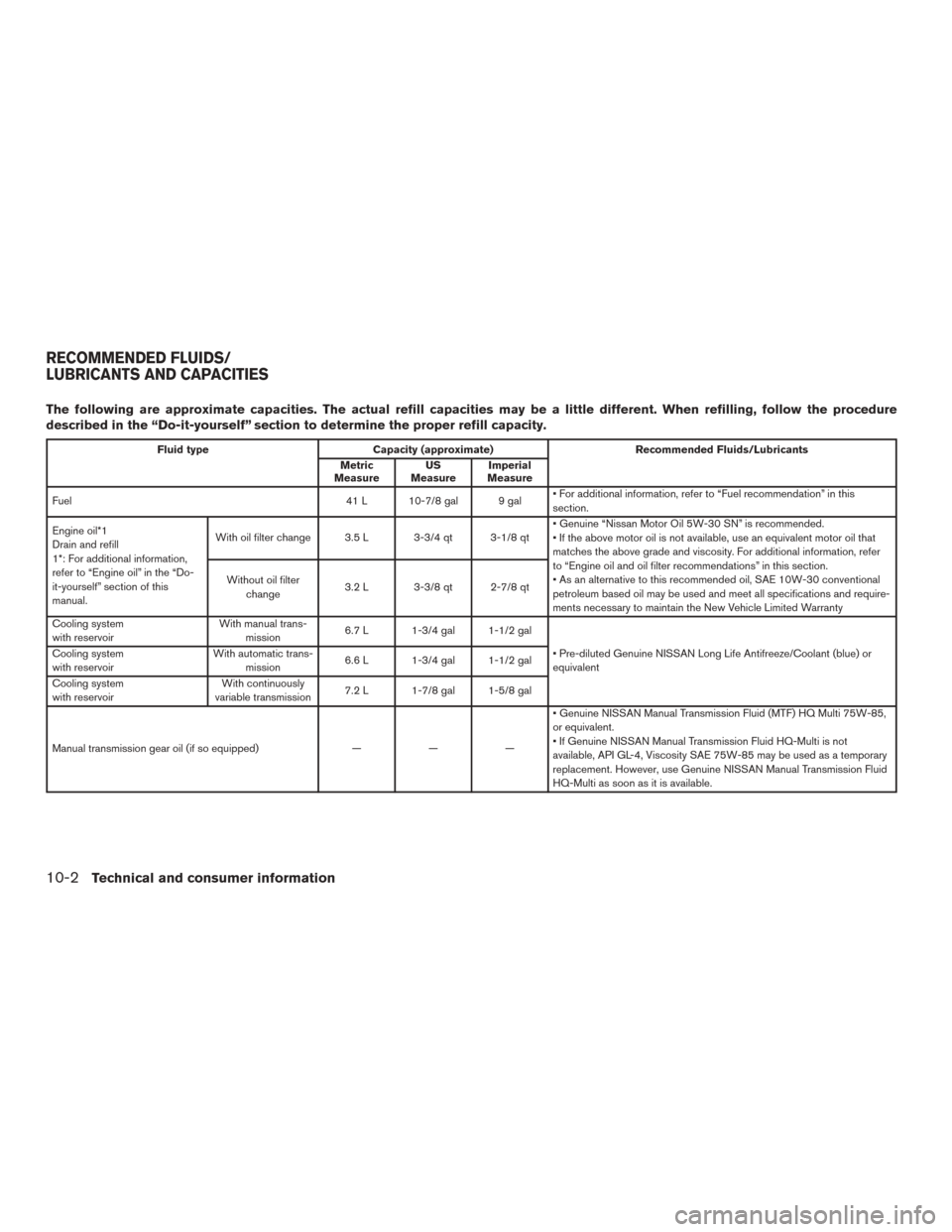
The following are approximate capacities. The actual refill capacities may be a little different. When refilling, follow the procedure
described in the “Do-it-yourself” section to determine the proper refill capacity.
Fluid typeCapacity (approximate) Recommended Fluids/Lubricants
Metric
Measure US
Measure Imperial
Measure
Fuel 41 L 10-7/8 gal 9 gal• For additional information, refer to “Fuel recommendation” in this
section.
Engine oil*1
Drain and refill
1*: For additional information,
refer to “Engine oil” in the “Do-
it-yourself” section of this
manual. With oil filter change 3.5 L 3-3/4 qt 3-1/8 qt
• Genuine “Nissan Motor Oil 5W-30 SN” is recommended.
• If the above motor oil is not available, use an equivalent motor oil that
matches the above grade and viscosity. For additional information, refer
to “Engine oil and oil filter recommendations” in this section.
• As an alternative to this recommended oil, SAE 10W-30 conventional
petroleum based oil may be used and meet all specifications and require-
ments necessary to maintain the New Vehicle Limited Warranty
Without oil filter
change 3.2 L 3-3/8 qt 2-7/8 qt
Cooling system
with reservoir With manual trans-
mission 6.7 L 1-3/4 gal 1-1/2 gal
• Pre-diluted Genuine NISSAN Long Life Antifreeze/Coolant (blue) or
equivalent
Cooling system
with reservoir With automatic trans-
mission 6.6 L 1-3/4 gal 1-1/2 gal
Cooling system
with reservoir With continuously
variable transmission 7.2 L 1-7/8 gal 1-5/8 gal
Manual transmission gear oil (if so equipped) ———• Genuine NISSAN Manual Transmission Fluid (MTF) HQ Multi 75W-85,
or equivalent.
• If Genuine NISSAN Manual Transmission Fluid HQ-Multi is not
available, API GL-4, Viscosity SAE 75W-85 may be used as a temporary
replacement. However, use Genuine NISSAN Manual Transmission Fluid
HQ-Multi as soon as it is available.
RECOMMENDED FLUIDS/
LUBRICANTS AND CAPACITIES
10-2Technical and consumer information
Page 397 of 404
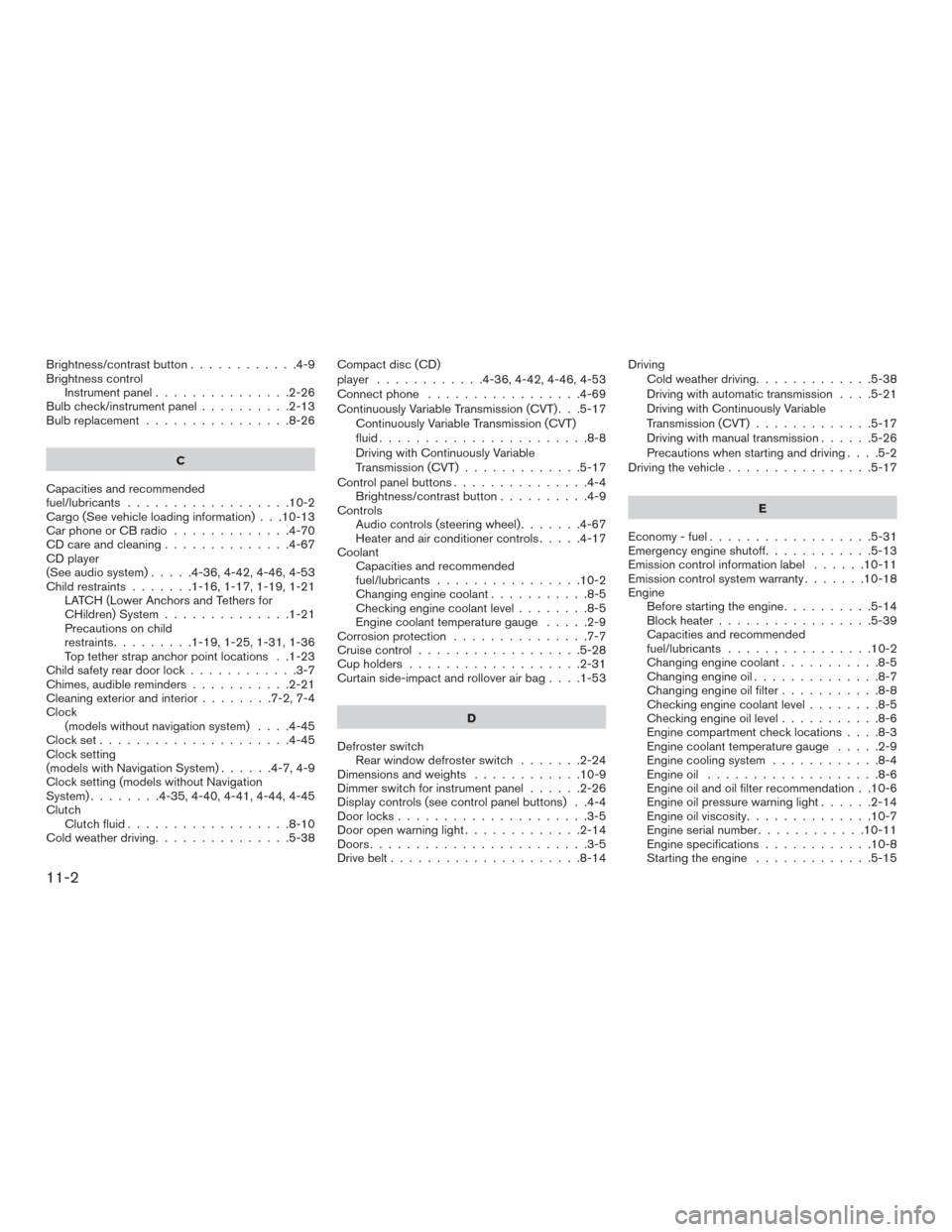
Brightness/contrastbutton............4-9
Brightness controlInstrument panel ...............2-26
Bulb check/instrument panel ..........2-13
Bulb replacement ................8-26
C
Capacities and recommended
fuel/lubricants ..................10-2
Cargo (See vehicle loading information) . . .10-13
Car phone or CB radio .............4-70
CD care and cleaning ..............4-67
CD player
(See audio system) .....4-36,4-42,4-46,4-53
Child restraints .......1-16,1-17,1-19,1-21
LATCH (Lower Anchors and Tethers for
CHildren) System ..............1-21
Precautions on child
restraints.........1-19,1-25,1-31,1-36
Top tether strap anchor point locations . .1-23
Child safety rear door lock ............3-7
Chimes, audible reminders ...........2-21
Cleaningexteriorandinterior........7-2,7-4
Clock (models without navigation system) ....4-45
Clockset.....................4-45
Clock setting
(models with Navigation System) ......4-7,4-9
Clock setting (models without Navigation
System) ........4-35,4-40,4-41,4-44,4-45
Clutch Clutch fluid ..................8-10
Cold weather driving ...............5-38 Compact disc (CD)
player ............4-36,4-42,4-46,4-53
Connect phone
.................4-69
Continuously Variable Transmission (CVT) . . .5-17 Continuously Variable Transmission (CVT)
fluid.......................8-8
Driving with Continuously Variable
Transmission (CVT) .............5-17
Control panel buttons ...............4-4
Brightness/contrast button ..........4-9
Controls Audio controls (steering wheel) .......4-67
Heater and air conditioner controls .....4-17
Coolant Capacities and recommended
fuel/lubricants ................10-2
Changingenginecoolant...........8-5
Checking engine coolant level ........8-5
Engine coolant temperature gauge .....2-9
Corrosion protection ...............7-7
Cruisecontrol..................5-28
Cupholders...................2-31
Curtainside-impactandrolloverairbag....1-53
D
Defroster switch Rear window defroster switch .......2-24
Dimensionsandweights ............10-9
Dimmer switch for instrument panel ......2-26
Display controls (see control panel buttons) . .4-4
Door locks .....................3-5
Door open warning light .............2-14
Doors ........................3-5
Drive belt .....................8-14 Driving
Cold weather driving .............5-38
Driving with automatic transmission ....5-21
Driving with Continuously Variable
Transmission (CVT) .............5-17
Driving with manual transmission ......5-26
Precautions when starting and driving ....5-2
Driving the vehicle ................5-17
E
Economy-fuel..................5-31
Emergency engine shutoff ............5-13
Emission control information label ......10-11
Emission control system warranty .......10-18
Engine Before starting the engine ..........5-14
B l
ockheater.................5-39
Capacities and recommended
fuel/lubricants ................10-2
Changing engine coolant ...........8-5
Changingengineoil..............8-7
Changing engine oil filter ...........8-8
Checking engine coolant level ........8-5
Checking engine oil level ...........8-6
Engine compartment check locations ....8-3
Engine coolant temperature gauge .....2-9
Engine cooling system ............8-4
Engineoil ...................8-6
Engine oil and oil filter recommendation . .10-6
Engine oil pressure warning light ......2-14
Engine oil viscosity ..............10-7
Engine serial number ............10-11
Engine specifications ............10-8
Starting the engine .............5-15
11-2
Page 398 of 404
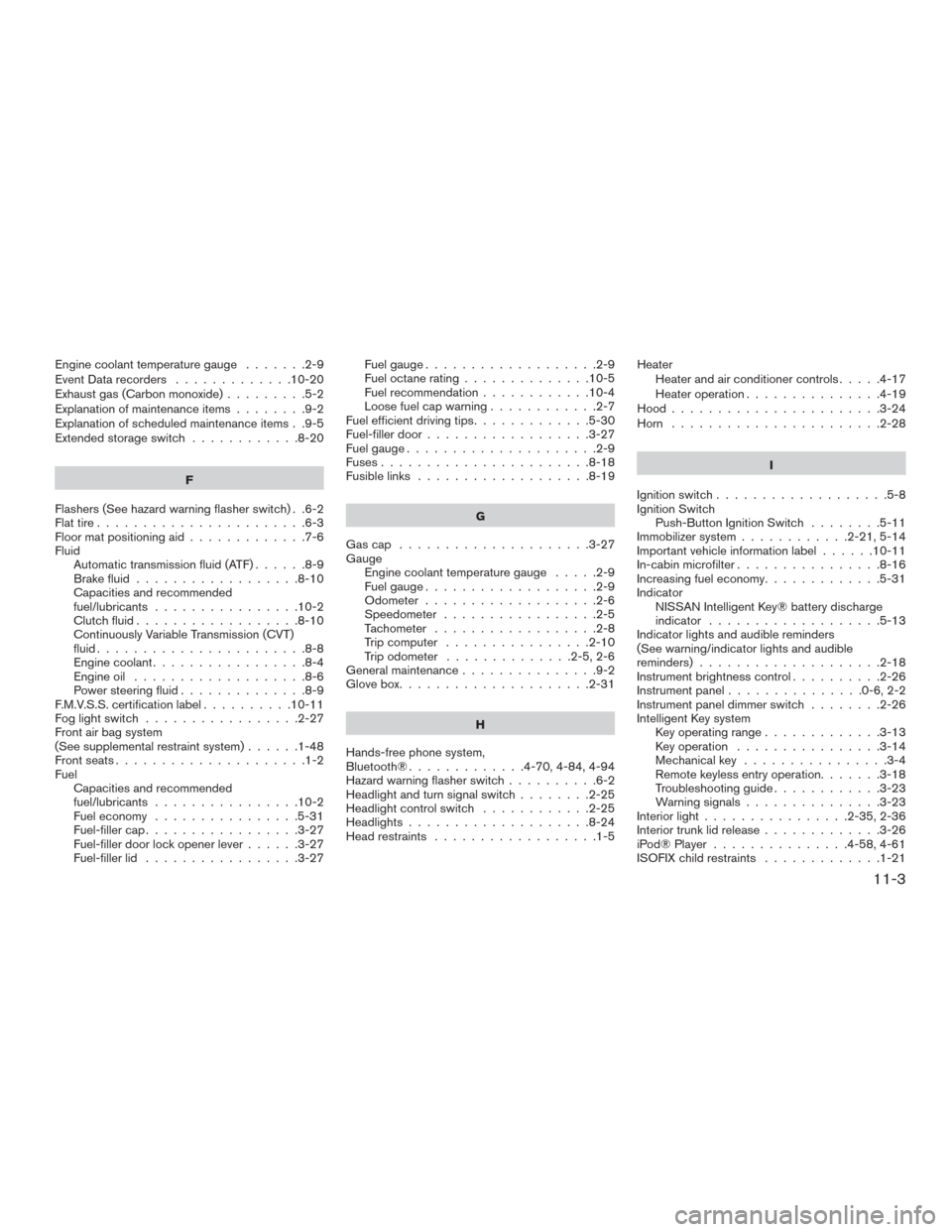
Engine coolant temperature gauge.......2-9
Event Data recorders .............10-20
Exhaust gas (Carbon monoxide) .........5-2
Explanation of maintenance items ........9-2
Explanation of scheduled maintenance items . .9-5
Extendedstorageswitch ............8-20
F
Flashers (See hazard warning flasher switch) . .6-2
Flat tire .......................6-3
Floor mat positioning aid .............7-6
Fluid Automatic transmission fluid (ATF) ......8-9
Brake fluid ..................8-10
Capacities and recommended
fuel/lubricants ................10-2
Clutchfluid..................8-10
Continuously Variable Transmission (CVT)
fluid.......................8-8
Engine coolant .................8-4
Engine oil ...................8-6
Power steering fluid ..............8-9
F.M.V.S.S. certification label ..........10-11
Foglightswitch .................2-27
Front air bag system
(See supplemental restraint system) ......1-48
Frontseats.....................1-2
Fuel Capacities and recommended
fuel/lubricants ................10-2
Fuel economy ................5-31
Fuel-filler cap .................3-27
Fuel-filler door lock opener lever ......3-27
Fuel-filler lid .................3-27 Fuel gauge
...................2-9
Fuel octane rating ..............10-5
Fuel recommendation ............10-4
Loose fuel cap warning ............2-7
Fuel efficient driving tips .............5-30
Fuel-filler door ..................3-27
Fuelgauge.....................2-9
Fuses.......................8-18
Fusiblelinks ...................8-19
G
Gascap .....................3-27
Gauge Engine coolant temperature gauge .....2-9
Fuel gauge ...................2-9
Odometer ...................2-6
Speedometer .................2-5
Tachometer ..................2-8
Trip computer ................2-10
Trip odometer ..............2-5,2-6
General maintenance ...............9-2
Glovebox.....................2-31
H
Hands-free phone system,
Bluetooth®.............4-70,4-84,4-94
Hazard warning flasher switch ..........6-2
Headlight and turn signal switch ........2-25
Headlight control switch ............2-25
Headlights ....................8-24
Head restraints ..................1-5 Heater
Heater and air conditioner controls .....4-17
Heater operation ...............4-19
Hood.......................3-24
Horn .......................2-28
I
Ignition switch ...................5-8
Ignition Switch Push-Button Ignition Switch ........5-11
Immobilizer system ............2-21,5-14
Important vehicle
information label ......10-11
In-cabin microfilter ................8-16
Increasing fuel economy .............5-31
Indicator NISSAN Intelligent Key® battery discharge
indicator ...................5-13
Indicator lights and audible reminders
(See warning/indicator lights and audible
reminders)....................2-18
Instrument brightness control ..........2-26
Instrumentpanel...............0-6,2-2
Instrument panel dimmer switch ........2-26
Intelligent Key system Key operating range .............3-13
Key operation ................3-14
Mechanical key ................3-4
Remote keyless entry operation.......3-18
Troubleshooting guide ............3-23
Warning signals ...............3-23
Interior light ................2-35,2-36
Interior trunk lid release .............3-26
iPod®Player ............... 4-58, 4-61
ISOFIX child restraints .............1-21
11-3
Page 401 of 404
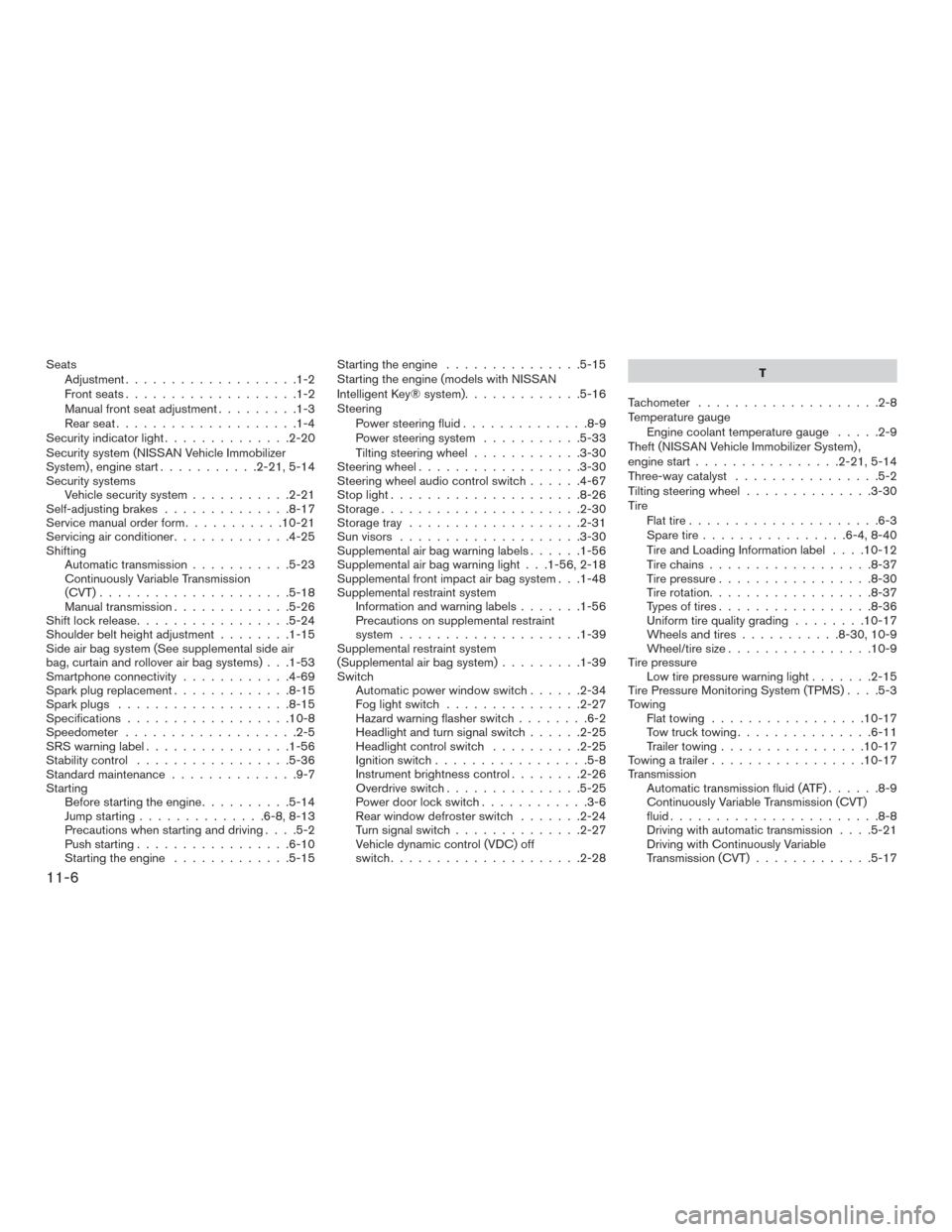
SeatsAdjustment ...................1-2
Frontseats...................1-2
Manual front seat adjustment .........1-3
Rear seat ....................1-4
Security indicator light ..............2-20
Security system (NISSAN Vehicle Immobilizer
System) , engine start ...........2-21,5-14
Security systems Vehicle security system ...........2-21
Self-adjusting brakes ..............8-17
Service manual order form ...........10-21
Servicing air conditioner .............4-25
Shifting Automatic transmission ...........5-23
Continuously Variable Transmission
(CVT) .....................5-18
Manual transmission .............5-26
Shift lock release .................5-24
Shoulder belt height adjustment ........1-15
Side air bag system (See supplemental side air
bag, curtain and rollover air bag systems) . . .1-53
Smartphone connectivity ............4-69
Spark plug replacement .............8-15
Spark plugs ...................8-15
Specifications ..................10-8
Speedometer ...................2-5
SRS warning label ................1-56
Stability control .................5-36
Standardmaintenance..............9-7
Starting Before starting the engine ..........5-14
Jump starting ..............6-8,8-13
Precautions when starting and driving ....5-2
Push starting .................6-10
Starting the engine .............5-15 Starting the engine
...............5-15
Starting the engine (models with NISSAN
Intelligent Key® system) .............5-16
Steering Power steering fluid ..............8-9
Power steering system ...........5-33
Tilting steering wheel ............3-30
Steeringwheel..................3-30
Steering wheel audio control switch ......4-67
Stoplight.....................8-26
Storage......................2-30
Storage tray ...................2-31
Sun visors ....................3-30
Supplemental air bag warning labels ......1-56
Supplemental air bag warning light . . .1-56, 2-18
Supplemental front impact air bag system . . .1-48
Supplemental restraint system Information and warning labels .......1-56
Precautions on supplemental restraint
system ....................1-39
Supplemental restraint system
(Supplemental air bag system) .........1-39
Switch Automatic power window switch ......2-34
Foglightswitch ...............2-27
Hazard warning flasher switch ........6-2
Headlight and turn signal switch ......2-25
Headlight control switch ..........2-25
Ignition switch .................5-8
Instrument brightness control ........2-26
Overdrive switch ...............5-25
Power door lock switch ............3-6
Rear window defroster switch .......2-24
T urn
signal switch ..............2-27
Vehicle dynamic control (VDC) off
switch.....................2-28 T
Tachometer ....................2-8
Temperature gauge Engine coolant temperature gauge .....2-9
Theft (NISSAN Vehicle Immobilizer System) ,
engine start ................2-21,5-14
Three-way catalyst ................5-2
Tilting steering wheel ..............3-30
Tire Flat tire .....................6-3
Spare tire ................6-4,8-40
Tire and Loading Information label ....10-12
Tire chains ..................8-37
Tire pressure .................8-30
Tire rotation..................8-37
Types of tires .................8-36
Uniform tire quality grading ........10-17
Wheels and tires ...........8-30,10-9
Wheel/tire size ................10-9
Tire pressure Low tire pressure warning light .......2-15
Tire Pressure Monitoring System (TPMS) ....5-3
Towing Flattowing.................10-17
Towtrucktowing...............6-11
Trailer towing ................10-17
Towing a trailer .................10-17
Transmission Automatic transmission fluid (ATF) ......8-9
Continuously Variable Transmission (CVT)
fluid.......................8-8
Driving with automatic transmission ....5-21
Driving with Continuously Variable
Transmission (CVT) .............5-17
11-6